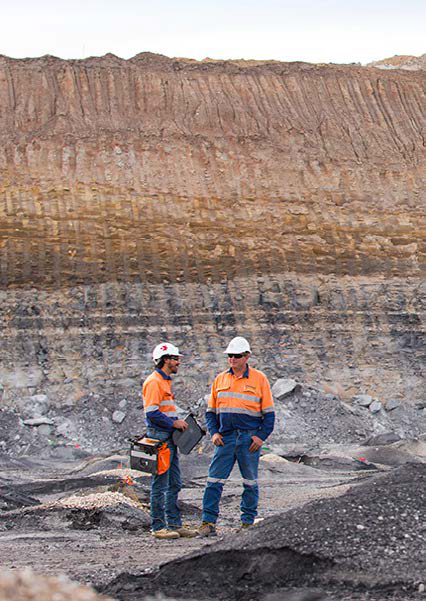
DAVEY BICKFORD ENAEX CASE STUDY
RICHMOND HILLS CONSTRUCTION
Blasting under residential vibration constraints
The blast site was located in the suburb of Richmond Hills, Mackay, Queensland. The land is currently under development for residential purposes by Pointglen Developments.
The development is partially completed with occupied houses already located in the nearby areas. Drill and blast services were supplied by Caruana Blasting.
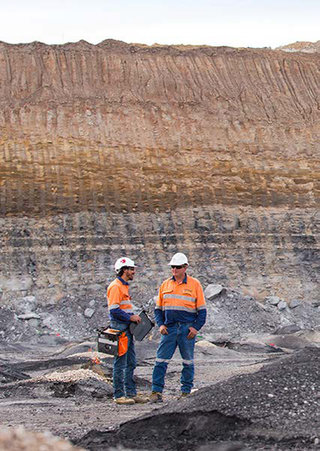
DaveyBickfordEnaex.com
Scroll down ▼
THE Situation
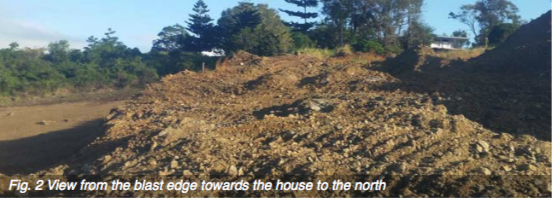
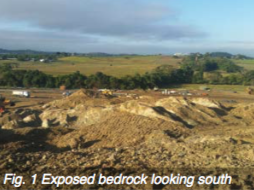
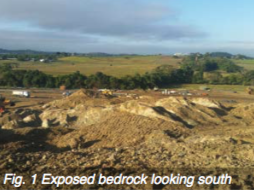
The geology of the site prompted significant earthworks to provide suitable foundations for house blocks. A portion of the site was located on the side of a hill which required drilling and blasting of bedrock to attain a desired reduced level. Caruana Blasting was contracted to complete this work. The loose surface material was initially removed to expose the bedrock below which varied in depth across the site (Fig. 1).
Concerns were raised regarding a number of neighbouring critical structures:
- A pre-existing occupied house 90m to the north-east (Fig. 2)
- Completed works between 15-45m to the east (including watermains, stormwater drains, underground electrical works, completed roadworks, etc.)
- Occupied houses within the new estate to the east
- A disused brick chimney 400m to the south (Fig. 3). The chimney is located on the site of the Richmond Mill constructed in 1881 and is listed on the Queensland Fig. 1 Exposed bedrock looking south heritage Register.
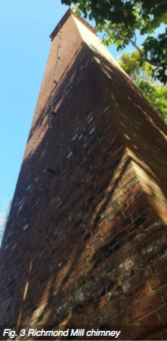

Caruana Blasting contacted Davey Bickford Enaex to complete a full site evaluation and develop an electronic timing design that would ensure vibrations are controlled at the key locations surrounding the blast.




Caruana Blasting contacted Davey Bickford Enaex to complete a full site evaluation and develop an electronic timing design that would ensure vibrations are controlled at the key locations surrounding the blast.
DAVEY BICKFORD ENAEX CASE STUDY
RICHMOND HILLS CONSTRUCTION
our Solution
The blast pattern was designed and drilled by Caruana Blasting. The pattern consisted of 871 holes drilled in a 2.5 m by 2.5 m square pattern. The hole diameter used was 89 mm. The solution proposed by the Davey Bickford Enaex’s Global Technical Services (GTS) team was comprised of two components. The first being to establish a site law to determine a maximum charge weight for each hole. Secondly, advanced vibration modelling using Paradigm software to correlate the timing design with any potential superposition of shock waves at key structures.
To complete the modelling process, vibrational seed wave data was required for the specific geological conditions experienced on site. To gather the necessary data, four blastholes from the predrilled blast pattern were selected to be fired as seed holes on the 15th August 2018. Vibration monitors were placed at the key structures surrounding the blast site and measured vibrations during the time of blasting. An aerial photo of the blast and surrounding area is provided in Fig. 4.
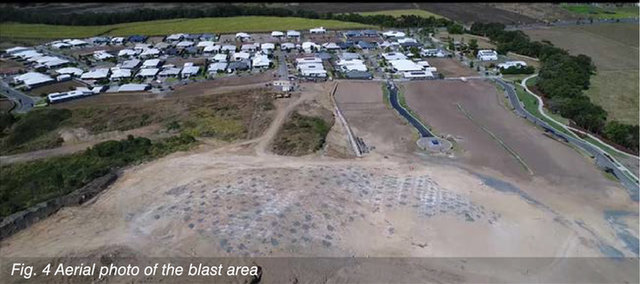
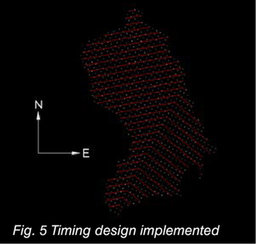
To control final fragmentation and potential flyrock hazards, loading was completed on a hole by hole basis. Each hole’s drill log was evaluated to determine the depth at which rock was located with bulk explosive only loaded within drilled rock. A site law was calculated and found a maximum charge weight of 11 kg per hole needed to be enforced while loading. 96 holes out of 867 (11%) production holes, required charge weights over the imposed limit to ensure suitable fragmentation of the rock. To account for these, the charge was split between two separate decks. A 4 ms time offset was applied to the top deck which prevented the simultaneous initiation of the hole’s entire charge.
The final timing design consisted of an asymmetrical V initiated from the south-west (Fig. 5). The timing design ensured that energy from the blast was directed away from critical structures.
The RESULT
The blast was fired on the 22nd August 2018 at 2 pm. Environmental monitoring of key locations found that peak vibration measurements were well below the limits imposed of 10 mm/s and no structural concerns were identified. Material movement during blasting was minimal since the overarching goal was to only fracture the rocks for future excavation.
Excellent hole by hole loading QA/QC by Caruana Blasting ensured no issues arose regarding unforeseen blasting hazards such as flyrock, or overpressure. Overall, the blast was an overwhelming success thanks to the accurate drilling and loading practices of Caruana Blasting’s team and the control of vibrations and energy through the Daveytronic system.
BLAST VIDEO
info@DaveyBickfordEnaex.com.au
Suite 4, 37 Cedric Street, Stirling, WA 6021
+61 8 9207 1066

